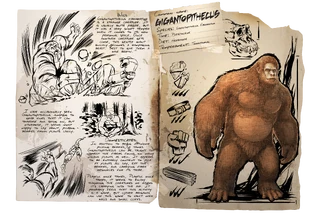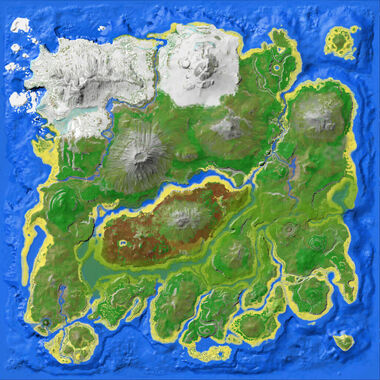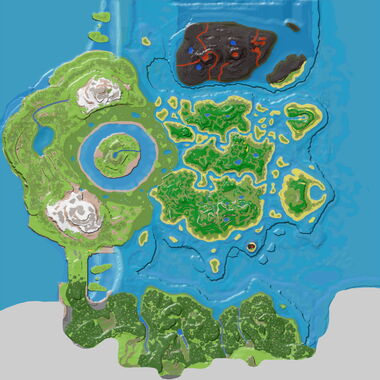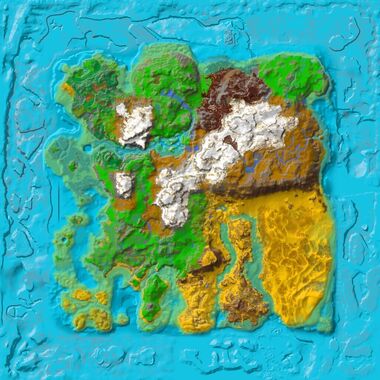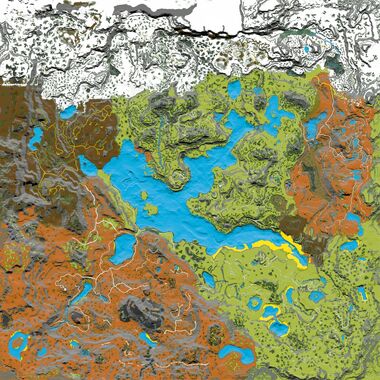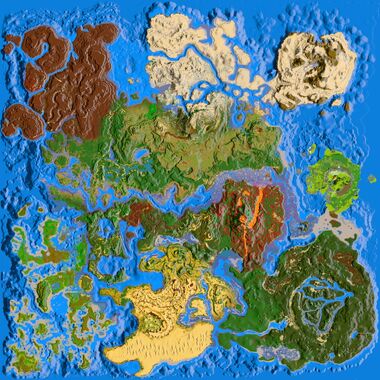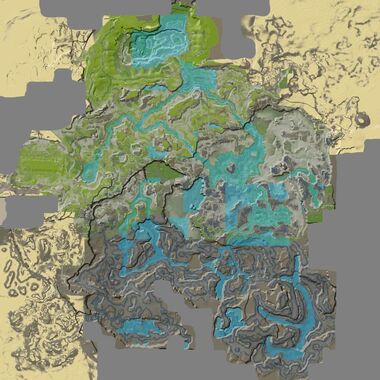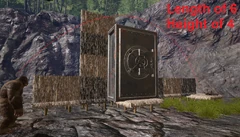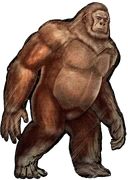Plantilla:See also
 Aberrant Gigantopithecus
Aberrant Gigantopithecus Eerie Gigantopithecus
Eerie Gigantopithecus Eerie Yeti
Eerie Yeti Megapithecus Pestis
Megapithecus Pestis Yeti
Yeti
or
cheat SpawnDino "Blueprint'Blueprint'/Game/PrimalEarth/Dinos/Bigfoot/Bigfoot_Character_BP.Bigfoot_Character_BP" 500 0 0 35
Variant Aberrant Gigantopithecus
cheat SpawnDino "Blueprint'/Game/PrimalEarth/Dinos/Bigfoot/Bigfoot_Character_BP_Aberrant.Bigfoot_Character_BP_Aberrant'" 500 0 0 35
Variant Gigantopithecus (Hunt2)
cheat SpawnDino "Blueprint'/Game/Genesis2/Missions/Hunt/Dinos/Bigfoot_Character_BP_Hunt.Bigfoot_Character_BP_Hunt'" 500 0 0 35
Variant Gigantopithecus (Gauntlet2)
cheat SpawnDino "Blueprint'/Game/Genesis2/Missions/ModularMission/Gauntlet2/STA/Dinos/Bigfoot_Character_BP_STA.Bigfoot_Character_BP_STA'" 500 0 0 35
Variant Gigantopithecus (Mashup)
cheat SpawnDino "Blueprint'/Game/Genesis2/Missions/ModularMission/Mashup/ExperimentG/DinosAndStructures/Bigfoot_Character_BP_ExpG_Pod.Bigfoot_Character_BP_ExpG_Pod'" 500 0 0 35
 Aberrant Megalosaurus
Aberrant Megalosaurus Argentavis
Argentavis Blood Crystal Wyvern
Blood Crystal Wyvern Ember Crystal Wyvern
Ember Crystal Wyvern Fire Wyvern
Fire Wyvern Forest Wyvern
Forest Wyvern Ice Wyvern
Ice Wyvern Karkinos
Karkinos Lightning Wyvern
Lightning Wyvern Megalosaurus
Megalosaurus Poison Wyvern
Poison Wyvern Quetzal
Quetzal Tek Quetzal
Tek Quetzal Tropical Crystal Wyvern
Tropical Crystal Wyvern Tusoteuthis
Tusoteuthis X-Argentavis
X-Argentavis
Común
Rara
No domesticable
Cueva
|
The Gigantopithecus (jy-gan-toe-pith-i-kus) is one of the Creatures in ARK: Survival Evolved.
Basic Info[]
Dossier[]
Esta sección pretende ser una copia exacta de lo que ha escrito el superviviente Helena Walker, autor(a) de los dossiers. Puede haber algunas discrepancias entre este texto y la criatura del juego.creature.
Behavior[]
Gigantopithecus wander around the forests of the island, eating berries off of bushes. They are naturally peaceful creatures, but will fight back if attacked or if a player or tamed creature makes physical contact with them. Gigantopithecus normally spawn as individuals and are fairly spread out, so it is rare to see groups of them in the wild. While they mainly inhabit forests, they tend to wander quite far and can sometimes be found on beaches or near rivers and mountains.
Yeti (Variant)[]
With the introduction of the Snow Cave in Patch 237, a variant of Gigantopithecus spawns inside called the Yeti. They are untamable apes that only spawn inside the snow cave at levels up to 350. These apes are vicious, terrifying creatures that will decimate any adventurers hoping to step foot inside. Stay clear from them, or use extremely powerful guns and weaponry to slaughter them before they get their powerful hands on you!
Appearance[]
The Gigantopithecus is a close relative of the modern orangutan. However, it stands upright like a man but slightly taller, giving it a strong resemblance to Bigfoot or the yeti.
Color Scheme and Regions[]
This section displays the Gigantopithecus's natural colors and regions. For demonstration, the regions below are colored red over an albino Gigantopithecus. The colored squares shown underneath each region's description are the colors that the Gigantopithecus will randomly spawn with to provide an overall range of its natural color scheme. Hover your cursor over a color to display its name and ID.
This information can be used to alter the Gigantopithecus's regions by entering cheat SetTargetDinoColor <ColorRegion> <ColorID> in the cheat console. For instance, cheat SetTargetDinoColor 0 6 would color the Gigantopithecus's "fur mane" magenta.
Drops[]
Base Stats and Growth[]
Ten en cuenta, que las estadísticas podrán variar en ARK:Survival of the fittest, y en ARK:Mobile
| Atributos | Cantidad a nivel 1 | Aumento por cada punto | Bonif. por domesticación | ||
|---|---|---|---|---|---|
| Salvaje | Domesticado1 | Add | Mult | ||
| 640 | +64 | +5.4% | 0.07 | ||
| 300 | +30 | +10% | |||
| 150 | +15 | +10% | |||
| 1500 | +150 | +10% | |||
| 220 | +4.4 | +4% | |||
| 40 / 602 | +1.6 / +2.4 | +1.7% | 7% | 17.6% | |
| 100% | N/A3 | +1% | 6% | ||
| 1100 | +66 | N/A4 | 0.5 | ||
1Los porcentajes se basan en el valor de la estadística al momento de ser domesticada (es decir, después de aplicarse la efectividad de tameo.)
2Aquí, se muestra el Daño base en bruto, en lugar de mediante porcentajes.
3Las criaturas salvajes no incrementan su velocidad de movimiento al subir de nivel.
4La Inconsciencia aumenta con los niveles, pero no puede ser subida manualmente una vez ha sido domesticada.
- Para ver una comparación de todas las estadísticas de las criaturas, consulta Estadísticas de criatura base.
- Para una explicación de cómo se calcula la subida de nivel, comprueba los cálculos de estadísticas para criaturas.
| Tipo de movimiento | Velocidad base | Corriendo | Energía usada | |
|---|---|---|---|---|
| Salvaje | Domesticado | |||
| Caminando | 195 | 682.5 | 1023.75 | 10 |
| Nadando | 300 | N/A | N/A | N/A |
- Estas son las velocidades base con un 100 % de velocidad de movimiento
- Para una comparación de todas las velocidades de movimiento, consulta Velocidad base de criaturas
| Stamina Cost | Attack Range | Description | |||||||||||
|---|---|---|---|---|---|---|---|---|---|---|---|---|---|
| Base | Minimum | Activation | |||||||||||
Aumento de estadísticas al subir nivel en estado salvaje
Escribe los valores de la criatura salvaje para revisar en que estadísticas sobresale más. Los valores marcados con verde en una criatura de alto nivel son muy buenos para la crianza/reproducción. Si ya has domesticado una criatura, puedes intentar recuperar la información que tenía cuando era salvaje con la siguiente herramienta: ARK Stats Extractor.
Nota: después de que la criatura sea domesticada, conseguirá algunas bonificaciones a sus estadísticas dependiendo de la efectividad del domesticado. Esto dificulta el obtener los niveles precisos de una criatura domesticada, por lo que esta calculadora te ayudará mucho, ya que está pensada para dinosaurios salvajes únicamente. Con ella, podrás tener una idea sobre la distribución de las estadísticas de una criatura.
Taming[]
| Feeding Interval | Time | ||
|---|---|---|---|
| Archivo:Kibble (Regular Egg).png Kibble (Regular Egg) | 5 | 03:02 | 0:12:09 |
| 36 | 01:52 | 1:05:37 | |
| 36 | 01:52 | 1:05:37 | |
| 36 | 01:52 | 1:05:37 | |
| 36 | 03:44 | 2:11:14 | |
| Feeding Interval | Time | ||
|---|---|---|---|
| Archivo:Kibble (Regular Egg).png Kibble (Regular Egg) | 7 | 02:50 | 0:17:00 |
| 52 | 01:51 | 1:34:47 | |
| 52 | 01:51 | 1:34:47 | |
| 52 | 01:51 | 1:34:47 | |
| 52 | 03:43 | 3:09:33 | |
| Feeding Interval | Time | ||
|---|---|---|---|
| Archivo:Kibble (Regular Egg).png Kibble (Regular Egg) | 10 | 02:41 | 0:24:17 |
| 69 | 01:50 | 2:05:46 | |
| 69 | 01:50 | 2:05:46 | |
| 69 | 01:50 | 2:05:46 | |
| 69 | 03:41 | 4:11:31 | |
| Feeding Interval | Time | ||
|---|---|---|---|
| Archivo:Kibble (Regular Egg).png Kibble (Regular Egg) | 12 | 02:38 | 0:29:08 |
| 86 | 01:50 | 2:36:45 | |
| 86 | 01:50 | 2:36:45 | |
| 86 | 01:50 | 2:36:45 | |
| 86 | 03:41 | 5:13:29 | |
| Feeding Interval | Time | ||
|---|---|---|---|
| Archivo:Kibble (Regular Egg).png Kibble (Regular Egg) | 14 | 02:36 | 0:34:00 |
| 104 | 01:50 | 3:09:33 | |
| 104 | 01:50 | 3:09:33 | |
| 104 | 01:50 | 3:09:33 | |
| 104 | 03:40 | 6:19:06 | |
| Feeding Interval | Time | ||
|---|---|---|---|
| Archivo:Kibble (Regular Egg).png Kibble (Regular Egg) | 17 | 02:34 | 0:41:17 |
| 121 | 01:50 | 3:40:32 | |
| 121 | 01:50 | 3:40:32 | |
| 121 | 01:50 | 3:40:32 | |
| 121 | 03:40 | 7:21:04 | |
Tenga en cuenta que los valores son para los casos óptimos, siempre llevar suministros adicionales!
Para obtener un valor más aproximado de los recursos necesarios, prueba Calculadoras externas de doma.
No hay resultados
Taming Strategies[]
Similar to the Ichthyosaurus, Gigantopithecus is tamed by hand-feeding rather than through the use of tranquilizers. To feed one you will need to be level 30, then place an appropriate food in the far-right slot of your hotbar and get close enough to the creature for the button prompt to appear. Gigantopithecus will take one piece of the food from your inventory and will play an eating animation. You must wait for the creature's hunger to go back down before it can be fed again, a process which takes some time, depending on the level and the food (see tables).
If you come into physical contact with Gigantopithecus while you are trying to feed it, the creature will attack. You must get out of its line of sight in order for it to calm back down and be feed-able again. Your taming progress will not be reset if the creature attacks you, but you will lose taming effectiveness if you fight back.
Be careful when approaching Gigantopithecus while feeding, as it will randomly change directions or stop, causing you to run into it. It is better to approach it from behind while it's standing still, since the creature usually doesn't turn all the way around while wandering. Or you can crouch up to it and feed it that way as it will not attack you when you're crouched.
It is best to bring a flying mount in case you need to run away, since they can easily be flown above the Gigantopithecus and it will give up the chase a lot quicker than on the ground. If a flying mount is not available, fast ground mounts such as a Raptor are decent alternatives.
Taming Box[]
Simple[]
Another method is to trap the Gigantopithecus in a 1x1 room with no roof or a hatchframe. You can then feed it from above without having to worry about bumping into it or having it wander off, and wild carnivores will have a tougher time getting to it.
Advanced[]
The Gigantopithecus can also be trapped directly on spot so the camera has never to be moved during the process.
For this, it requires one foundation (Just even floor will not suffice), two fence foundations and five door frames. On the foundation, one fence foundations needs to be placed directly on the edge of it, and the second one should be snapped to the other one so it lays diagonally on the foundation. Now the foundation is separated in two triangles, and note that the triangles are of different sizes, and the bigger one will be the potential taming spot. Now it requires door frames on each but one side (So the Gigantopithecus can be lured into the box). After you have lured the Gigantopithecus into the box, close the last open side, and now it will walk around in the box (Aggressive or not), and you just have to keep one door frame projected at the diagonal fence foundation and place it as soon as possible. After it is placed, the Gigantopithecus barely has any possibility to move left.
When hand feeding him now, it is important to not stay on the foundation because then you have high risk of enraging it. It is advised to stay on the ground next to it and crouch, then it can be fed without any problems.
Building material[]
It is advised to use stone because it can easily become enraged by accident, but with enough care, wooden structures will also suffice (Thatch won't because it will be broken in the process of luring it in the box and losing aggro).
Luring into the box[]
Since dropping it in the box with a flying mount is pretty hard and only possible with a Quetzal or Argentavis, it is much easier to lure it into it. For this, leave one side of the box open at first and place a doorframe on the opposite side. Then, after getting its attention, you just run into the box, wait until it is close enough to actually enter it, and then just leave through the door frame (It cant pass through it) and close the opposite side with a spare wall.
Losing aggro[]
To lose its aggro, just travel vertically till the skybox is reached and instantly return. Horizontal travel to lose its interest is discouraged because it can cause the teleporting bug, which lets it exit the box (If this happens or not is dependent on the exact placement of the box), or may even let it despawn.
Sometimes, it may be still enraged and attacking the box when returning. In this case, you need to replace all wall/door structures it is attacking.
Using a Quetzal[]

To tame the Gigantopithecus using the Quetzal method, it requires 2 people. The first person needs to carry the Gigantopithecus with the Quetzal, and hover close the ground. While it's been carried, the Gigantopithecus can be fed, and is less likely to retaliate against the tamer. If the feeder gets too close, it will still throw a punch, but it wont affect the tame or aggro it. The Quetzal might slide around over time, so the Quetzal rider only has to adjust its position every now and then. Along with feeding the Quetzal food/stimberries to keep it flying. Alternative, on PC, the player riding the Quetzal can hold X to prevent it from moving in the air, thus allowing it to keep the Gigantopithecus completely still.
Utility[]
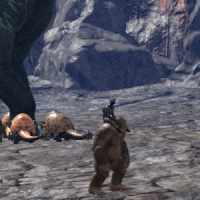
tossing animation (click to enlarge)
Human Tossing[]
When sitting on a Gigantopithecus and pressing the alt-fire button (default: right click), it will grab the survivor with the blue crosshair appearing in front of the HUD. It will toss him/her forward upon clicking again. This can be used to get over walls without destroying them. Be careful as this does cause the Gigantopithecus to melee attack directly in front of it, damaging anything or anyone in the established path.
If you have the Glider Suit, this can give you an excellent bit of elevation to glide around and get a good view. The Gigantopithicus can easily follow you when gliding, if you know what you're doing. As well, if you deploy the parachute, it will carry you forwards for an incredible distance, faster than most animals can run, the downside being you won't have your Gigantopithicus to defend you when you finally land.
They are an excellent mount for gaining an acrobatic advantage if you know what you're doing. Also fun fact when tamed the fiber gathering/pickup attack does torpor to enemies and wild dinos so it can be used to knock players out for an easy kill.
Roles[]
- Tank: Excellent tank due to its high HP and ability to wear any type of helmet. (Level up in Health and Damage)
- Damage: Very good AOE, damage scaling and knockback. The knockback has also been known to push back a Brontosaurus slightly. (Level up in Damage, Health and Speed slightly)
- Armor killer: Damages through player's armor easily much like Arthropleura in Pvp. (Level up in Damage, Health and Speed slightly)
- Transport: Decent base carrying capacity but nothing absurd. Good base speed, similar to a player without any speed upgrades and can travel up and down ziplines like the ravager. (Level up in Speed, Stamina, and Weight)
- Shoulder Carrier: Ability to carry shoulder pets (Such as Charge Light Dino, Jerboa, Microraptor etc...) with good base speed. (Level up in Speed, Stamina, and Weight)
- To pick up a shoulder pet on XBOX use LB + Right Stick, same to throw the shoulder pet,
- For PS4 hold L1 (alternate hand) and then press and hold R3, same action will spawn a crosshair to throw the pet
- Gatherer: Can gather fiber, thatch, wood, and a decent amount of berries. Can gather fiber and rare flower passively when not ridden–will gather fiber from plants in its vicinity, otherwise turn on ability to wander to gather fiber continuously. Use C (RB on Xbox) to gather Fiber while ridden. (Level up in Damage, Weight, and Stamina)
- Hiker: Gigantopithecus may outmatch Pulmonoscorpius and Beelzebufo for hiking. They can climb the steepest surfaces with relative ease. And can also climb ziplines being very useful in Aberration and the underground forest in Extinction.
- Caving: Arguably the best mount you can travel through in caves. Small enough yet deal significant damage and can run fast enough to avoid fights. Should you get caught up in the lakes you can swim to safety.
Carry-able Creatures[]
The Gigantopithecus is capable of carrying the following shoulder-mounts, in addition to a human rider:
 Archaeopteryx
Archaeopteryx Bulbdog
Bulbdog Compy
Compy Dimorphodon
Dimorphodon Dodo
Dodo Dung Beetle
Dung Beetle Featherlight
Featherlight Ferox
Ferox Glowtail
Glowtail Ichthyornis
Ichthyornis Jerboa
Jerboa Mesopithecus
Mesopithecus Microraptor
Microraptor Otter
Otter Pegomastax
Pegomastax Shinehorn
Shinehorn Vulture
Vulture
Both ![]() Microraptor,
Microraptor, ![]() Dimorphodon and
Dimorphodon and ![]() Pegomastax will attack (or pickpocket, in Pegomastax's case) the opposing survivor if thrown towards them in PvP-enabled server.
Pegomastax will attack (or pickpocket, in Pegomastax's case) the opposing survivor if thrown towards them in PvP-enabled server.
![]() Ichthyornis will do the same thing as it does for survivors when thrown towards fish.
Ichthyornis will do the same thing as it does for survivors when thrown towards fish.
Can only pick ![]() Ferox when small. Also, when a small Ferox is carried, it will glitch and appear between the two Gigantopithecus' feet.
Ferox when small. Also, when a small Ferox is carried, it will glitch and appear between the two Gigantopithecus' feet.
- Controls
- Hold C to pick up.
- Tap/Hold C to aim and throw.
- Tap X to drop.
- Click Right Stick/Bumper simultaneously.
The Gigantopithecus can only target tribe-owned creatures, and cannot be used to pick up wild or enemy variants.
Collectibles[]
| Recurso | Eficiencia |
|---|---|
| ★★★★★ Gathers autonomously | |
| ★★★★☆ | |
| ★★★☆☆ | |
| ★★☆☆☆ | |
| Fiber can be gathered when Gigantopithecus is wandering, and while ridden with C, | |
Combat[]
This section describes how to fight against the Gigantopithecus.
General[]
The Gigantopithecus has fairly good health and attack, since it is passive until you get too close it is easy to avoid if you don't think you can handle it.
Strategy[]
Gigantopithecus has a good amount of knockback, this can be used to your advantage if you're using ranged weaponry and have fairly good armor or health. Keep walking backwards while attacking it with ranged attacks, and if it hits you use the knockback to give yourself more distance to keep attacking them.
Weaponry[]
Using a quetzal to pick up the gigantopithecus can be an effective way to easily kill it.
Dangers[]
A Wild Gigantopithecus Is known to be passive, but if you bump into it as you try to feed it berries to Tame it, it will attack you so careful not to get too close when taming. If it agros you simply run away until it stops chasing, taming progress will not be lost. If you attack it, it will not stop chasing and tame is likely to be ruined. Given the added ability to tear through armor, it is best not to attempt taming with equipment that are expensive to repair.
Weakness[]
Gigantopithecus' weakness is its strength. Gigantopithecus is known to knock you back on hit so if you survive you have a chance to run away. Once you are far enough the Gigantopithecus will ignore you and you can once again retry to tame it if so wish.
Spotlight[]
Notes/Trivia[]
Para más información sobre esta criatura en el mundo real, consulta el artículo de Wikipedia asociado
- Gigantopithecus means "giant ape" in Greek.
- First known creature to harvest fiber.
- In Single Player maps, exiting then reentering the game causes the Gigantopithecus to lose its hostility, which can make taming them much safer.
- Relic Gigantopithecus are one theory for sightings of large, hairy primates (Sasquatch, Yeti, etc.).
- This may have influenced the appearance of Ark's Gigantopithecus since it was thought to postured more like a gorilla in real life.
- This is also evidenced by its spawncode name being bigfoot.
- According to some scientists, Gigantopithecus was nearly 10 feet tall and thus the biggest ape that ever lived. Therefore, it would have weighed more than 500 kilograms, comparable to a full-grown polar bear.
- Dossier revealed on 06/24/2015.[1]
- Its full name Gigantopithecus fibrarator translates into "fiber gatherer giant ape", referring to its use as a fiber collector.
- Gigantopithecus received a major update for TLC Phase 1 on February 20, 2018 with an appearance overhaul, ability to jump and climb on zip lines (but not jump between like
 Ravager), throws like
Ravager), throws like  Karkinos, their attacks can break armor easier and can carry shoulder pets. They are also introduced in Aberration on the same day.
Karkinos, their attacks can break armor easier and can carry shoulder pets. They are also introduced in Aberration on the same day. - As of 8/25/2018 The Fresh Coffee Fruit in the ARK Primitive+ Ragnarok does not working on the Steam/PC version of the game, when taming the Gigantopithecus. However, testing some other items the Cane Sugar does work as well as the obvious Mejoberries.
- When the level 40 survivor cap was placed on taming the Gigantopithecus, there was an intent to eventually introduce a mechanic that would allow the leveling of a non-violent taming skill. However, this was never implemented for some unknown reason.
- The Western Jungles in the island are more likely habitats that Gigantopithecus would live in.
- The Gigantopithecus can be knocked out in the game, when they are knocked out the Gigantopithecus can not be tamed similar to most or passive tames.
Changelog[]
| Patch | Changes |
|---|---|
| 201.0 | |
| 201.1 |
|
| 201.2 |
|
| 201.4 | Gigantopithecus now properly gains |
| 202.0 | Survivor is now required to be level 40 or higher to tame a Gigantopithecus |
| 204.0 | Gigantopithecus can now manually harvest |
| 206.0 | Fixed where you could get instantly killed after dismounting from creatures like the Gigantopithecus |
| 223.0 | Added the creature "fur" pass to make hair and feathers look better |
| 237.0 | Added the |
| 252.7 | Herbivores buffed to have a 55% explosion resistance and a 65% fire resistance |
| 252.8 | Herbivore explosion resistance reduced from 55% to 40% |
| 259.0 | Added functionality to allow a player riding a Gigantopithecus to harvest |
| 278.0 TLC Phase 1 | Receives a model update, animation update, new fur and some new abilities:
|
| 278.1 |
Fixed issue where Gigantopithecus were not loading their stats values from previous savegames |
| 278.2 | Fixed an issue where the Aberrant Gigantopithecus couldn't be transfered off of Aberration |
Gallery[]
References[]
| Criaturas | |||||||||||||||||||||||||||||||||||||||||||||||||||||||||
|---|---|---|---|---|---|---|---|---|---|---|---|---|---|---|---|---|---|---|---|---|---|---|---|---|---|---|---|---|---|---|---|---|---|---|---|---|---|---|---|---|---|---|---|---|---|---|---|---|---|---|---|---|---|---|---|---|---|
| |||||||||||||||||||||||||||||||||||||||||||||||||||||||||
es:Gigantopithecus




